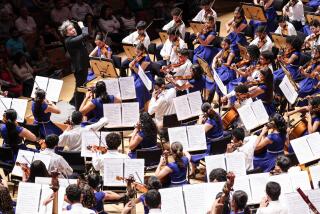MUSIC REVIEW : Quartet Offers Uneven Mozart Performance
LA JOLLA — Now that the San Diego Symphony and San Diego Opera have saluted the Mozart bicentennial year with performances of major Mozart works, it is reassuring that the intimate chamber works will receive their due. Sunday afternoon at the Athenaeum arts library in La Jolla, the Ensemble Elan, a quartet of local orchestra musicians, offered a pair of Mozart string quartets along with Joseph Haydn’s D Minor Quartet, Op. 76, No. 2, “Quinten.”
As first violinist Paul Severtson explained, it was only fitting to include a Haydn quartet on the program, since the two Mozart works, the E-flat Quartet, K. 428, and the C Major Quartet, K. 465 “Dissonance,” were both dedicated to Haydn. But Severtson had another motive for programming Haydn’s Op. 76, No. 2.
“My sister Susan and I are here to complete some unfinished business,” he stated as he motioned to the quartet’s other violinist, Susan Robboy. Severtson then produced a program from a 1960 Athenaeum concert in which he and his sister had performed a single movement of the Haydn Quartet, Op. 76, No. 2, as members of the Severtson Family String Quartet. Although this reviewer was not present for the performance 30 years ago, it is safe to assume that the violinists have made significant strides since their days as budding prodigies.
Despite their conviction for the idiom, however, Ensemble Elan lacked the polish these quartets require. The ensemble’s strongest suit was a vigorous and well-paced reading of the “Dissonance” Quartet. As a foil to the urgency of the finale, Ensemble Elan stressed the breadth and gravity of the slow movement.
Notable was the contribution of cellist Mary Oda Szanto, whose cleanly focused lines and thoughtfully articulated phrasing undergirded the work with admirable sympathy for classical style. Violinist Robboy and violist Ann Gref kept the inner voices fluent and lively.
Mozart’s E-flat Quartet, which opened the concert, suffered from wayward intonation and unfocused ensemble. Even the genial Minuet movement had an uneasy edge to it. Although Severtson has a slender violin timbre, hardly a liability in this repertory, he lacked the assertive leadership that would have helped shape this demanding string quartet. The Haydn Op. 76, No. 2, would also have benefited from tighter discipline, but the players clearly projected the work’s probing account of the darker side of the human psyche.
More to Read
The biggest entertainment stories
Get our big stories about Hollywood, film, television, music, arts, culture and more right in your inbox as soon as they publish.
You may occasionally receive promotional content from the Los Angeles Times.










